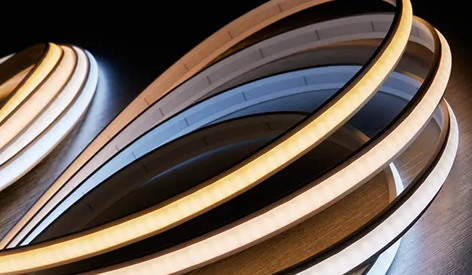Views: 0 Author: Site Editor Publish Time: 2025-07-07 Origin: Site
In the world of modern lighting, flexible lighting strips—also known as LED strip lights or ribbon lights—have revolutionized how we illuminate spaces. These thin, adaptable lighting solutions offer not only energy efficiency but also unmatched versatility, making them a top choice for a wide range of residential, commercial, and industrial applications.
From cozy ambient lighting under kitchen cabinets to dazzling architectural highlights in shopping malls or hotels, flexible LED strips are being used in creative and functional ways around the globe. Their slim profile and bendable nature allow them to be installed in tight corners, curved surfaces, and concealed spaces where traditional lighting would fail.
The growing popularity of flexible lighting strips can be attributed to several key advantages:
Easy customization and installation
Low power consumption
Long lifespan
Vibrant color options and dimming control
Thanks to continuous innovation in LED technology, companies like ORIENT LIGHTING Co., Ltd. now offer a wide range of flexible LED strip products tailored for indoor and outdoor environments. But how exactly do these lighting strips work? And what components make them reliable, efficient, and durable?
To understand the brilliance of flexible lighting strips, it’s essential to start with their core technology: LED (Light Emitting Diode) lighting. LED technology has transformed the lighting industry by offering high-efficiency illumination with minimal power consumption and extended lifespan. Flexible LED strips are a compact, adaptable embodiment of this innovation.
At the heart of every flexible lighting strip lies a series of small, surface-mounted LEDs—commonly SMD types like 2835, 3528, or 5050—attached to a narrow, flexible PCB (Printed Circuit Board). These LEDs emit light when a suitable electric current passes through a semiconductor material, causing electrons to release energy in the form of visible light. This is known as electroluminescence.
The color of the light (warm white, cool white, RGB, etc.) is determined by the materials used in the LED chip and, in some cases, by adding a phosphor coating. RGB and RGBW strips use three or four different LEDs per group to create multi-color outputs through additive color mixing.
Flexible lighting strips operate on low-voltage DC (direct current) power—typically 12V or 24V. This makes them not only energy-efficient but also safe for home and commercial installations.
A DC power adapter or transformer is required to convert the AC power from your wall outlet into a safe, usable DC voltage for the strip.
Choosing the right wattage is crucial: underpowering the strip may result in dim light or flickering, while overpowering can damage the circuit.
Many modern LED strips offer dimming functionality, which can be controlled via wall dimmers, remote controls, or smart home systems.
RGB and RGBW strips require an additional LED controller to adjust brightness, color, and effects. These controllers vary from simple IR remotes to advanced app-based or voice-controlled smart systems.
Advanced lighting systems often include DMX or Zigbee protocols for professional-grade control in stage lighting or architectural settings.
By combining low-voltage DC power with intelligent control systems, flexible lighting strips can mimic natural daylight, provide dynamic color effects, or create relaxing ambient lighting—depending on your needs.

The performance, durability, and functionality of a flexible lighting strip are largely determined by its internal components. While these lighting solutions may appear simple from the outside, they are engineered using several critical elements that work together to ensure consistent, safe, and efficient operation.
Below, we break down the key components that make up a high-quality flexible LED strip:
At the core of every flexible lighting strip are LED chips, typically of the SMD (Surface Mounted Device) variety. Common SMD types include:
SMD 3528 – Single diode per package, used for soft accent lighting.
SMD 2835 – Brighter and more efficient, suitable for task and ambient lighting.
SMD 5050 – Larger chips with multiple diodes, ideal for RGB and high-output strips.
SMD 5630 / 5730 – High-lumen output, often used in commercial applications.
The number of LEDs per meter (e.g., 60, 120, 240 LEDs/m) also affects brightness and power consumption.
The flexible circuit board serves as the foundation of the strip, enabling the LEDs and other components to be mounted in a stable, conductive pathway. High-quality PCBs are typically made of copper foil layers laminated on flexible substrates like polyimide or PET.
Advantages of a good-quality PCB include:
Better heat dissipation
Consistent voltage across long runs
Enhanced flexibility for curved or complex installations
Resistors are essential for regulating the current supplied to each LED, ensuring brightness uniformity and protecting the chips from overcurrent.
Capacitors may be used in some designs to smooth out voltage spikes or prevent flickering.
In more advanced LED strips—especially constant current models—a small driver module is integrated to provide stable, regulated current, enhancing performance over longer distances (e.g., up to 15 meters without brightness drop).
To adapt to various environments, flexible LED strips are often encased in protective layers such as:
Silicone – Highly transparent, UV-resistant, and flexible; widely used for waterproofing.
PU (Polyurethane) – Durable and soft; good for outdoor applications and flexible use.
Epoxy Resin – Tough and low-cost; used for simple indoor waterproofing needs.
These coatings provide IP65, IP67, or IP68 waterproof ratings, depending on the level of protection needed. They shield the components from dust, moisture, corrosion, and mechanical damage.
Flexible lighting strips come with various connectors and terminals to facilitate installation:
DC Power Connectors – Standard 2.1mm barrel jacks or screw terminals for power supply connections.
Cut Points and Solder Pads – Allow users to cut and reconnect strips at predefined intervals.
LED Controllers – Especially important for RGB/RGBW strips, enabling control over brightness, color changes, modes, and timing via remote, smartphone, or home automation systems.
Some advanced systems use plug-and-play connectors, while others require soldering for a more permanent installation.
When it comes to flexible lighting strips, not all products are created equal. The quality of each internal component—ranging from the LED chips to the flexible PCB and protective coating—directly affects performance, safety, and lifespan. That’s why it’s critical to choose a product from a trusted manufacturer that emphasizes material quality control and precision engineering.
At ORIENT LIGHTING, we adhere to strict manufacturing standards and quality assurance protocols to ensure every LED strip performs reliably under various environmental conditions. Our sourcing team selects only high-grade materials, such as:
Premium gold wire LED chips for optimal light consistency and low failure rate.
Double-layer pure copper PCBs for better heat dissipation and voltage uniformity.
UV- and salt-resistant silicone or PU coatings for maximum outdoor durability.
In addition to selecting high-performance materials, ORIENT LIGHTING employs automated production lines and 100% aging tests to verify product reliability before shipment. This attention to detail is especially important for professional projects such as hotels, public landmarks, and outdoor installations—where maintenance costs must be kept low and visual consistency is critical.
With a focus on long-term stability, our flexible LED strip lights are designed to offer over 50,000 hours of service life, making them a cost-effective lighting investment for any application.
The effectiveness and reliability of a flexible lighting strip depend heavily on both its design and the quality of its components. From the brightness of the LED chips to the heat dissipation capabilities of the PCB and the durability of its waterproof coating—every part plays a vital role in performance.
A well-engineered flexible LED strip offers not only brilliant lighting but also long-lasting stability, energy efficiency, and design flexibility. Whether you're illuminating a retail display, setting the mood in a home interior, or lighting up architectural landmarks, choosing a strip with superior components makes all the difference.
ORIENT LIGHTING Co., Ltd. delivers lighting solutions that go beyond aesthetics—we engineer for durability, efficiency, and safety. With customizable options and stringent quality control, our flexible LED strip lights meet the highest global standards, ensuring dependable illumination for every project.
INTEGRATE™ is a series of integrate flexible LED strips including single White, single Color, variable white, RGB, RGB pixel, RGBW and RGBVW. Various types would meet any your customized requirements. Integrate has dome surface as COB for soft and dot-less effect, same SMD technology as lighting sou
Flexible SMD LED strip lights have become one of the most popular lighting solutions in both residential and commercial environments. Their slim profile, low power consumption, and versatility make them suitable for accent lighting, task lighting, decorative installations, and even large-scale architectural illumination. Among the wide range of LED chips available today, SMD 3528 and SMD 5050 remain two of the most commonly used and widely recognized options.
SMD LED strip lights have become one of the most versatile and popular lighting solutions in modern homes, commercial environments, and creative projects. Their slim profile, flexible design, and energy efficiency make them ideal for accent lighting, task lighting, ambient illumination, and decorative installations. Yet one of the biggest questions users have—especially beginners—is whether SMD LED strip lights can be cut without damaging them.
LED strip lighting has become one of the most versatile and widely adopted solutions for modern residential, commercial, and architectural lighting. Among the different types of LED strips available today, SMD LED strip lights and COB LED strips are the two most popular choices. Each offers unique advantages, performance characteristics, and visual effects, making them suitable for different applications.
SMD LED strip lights have become one of the most versatile and widely used lighting solutions for residential, commercial, and industrial applications. From accent lighting in living rooms to large architectural installations and retail displays, LED strips offer flexibility, efficiency, and precise illumination control. However, managing long LED strips—especially those stretching beyond 5–10 meters—comes with unique challenges.
LED lighting has revolutionized the way homes, commercial spaces, and decorative environments are illuminated. Among the most popular modern lighting solutions, LED flexible strip lights stand out because they combine versatility, energy efficiency, and sleek aesthetics. Within this category, SMD LED strip lights have become the industry standard due to their compact size, strong brightness, and adaptability to a wide range of applications.
In the world of modern lighting, few products have transformed interior and exterior illumination as dramatically as SMD LED strip lights. Whether used for home decoration, retail ambiance, architectural highlights, or industrial applications, these flexible and efficient lighting tools offer unparalleled versatility. Their slim design, excellent brightness, and wide color options have made SMD LED strips a preferred choice for designers, homeowners, and engineers alike.
Light and color have long been understood to influence human emotions, behavior, and even physical well-being. From the moment we wake up to the time we go to sleep, the type of light surrounding us plays a vital role in shaping our moods, productivity, and overall state of mind. This is why understanding the psychology of light and color is crucial when selecting LED lighting for various environments, whether it's at home, in the office, or in commercial settings.
LED strip lights are a popular choice for modern lighting due to their energy efficiency, versatility, and sleek design. However, one crucial aspect that is often overlooked when using LED strips is thermal management. LED lights, like any other electronic component, generate heat as they operate, and if not properly managed, this heat can reduce their performance and lifespan.
Choosing the right LED strip lights for your home or office is a decision that requires careful consideration. LED strips have become an increasingly popular choice due to their versatility, energy efficiency, and aesthetic appeal. However, with so many options available on the market, it’s easy to feel overwhelmed by the number of different types and features.
Indirect lighting has become a popular choice for creating a soothing and stylish ambiance in both residential and commercial spaces. Unlike direct lighting, which often creates harsh shadows and bright spots, indirect lighting provides a more gentle and even illumination that enhances the atmosphere without overwhelming the eyes.
Proper lighting on boats or yachts is not just about enhancing the aesthetic appeal; it plays a crucial role in ensuring safety, functionality, and comfort on the water. Effective lighting can help improve visibility during nighttime navigation, set the mood for evening activities, and highlight specific areas of your vessel. One of the best lighting options for marine environments is LED strip lights. Their versatility, energy efficiency, and durability make them an excellent choice for a variety of marine applications.
To ensure that your LED strip lights continue to perform at their best and last as long as possible, proper care and installation are essential. LED strips are known for their longevity and energy efficiency, but several factors can influence how long they last. By following some simple yet effective maintenance tips, you can extend the lifespan of your LED strips and keep them running smoothly for years to come.
When purchasing LED strip lights for your home or business, you might notice various certifications listed on the product packaging or technical specifications. These certifications, often represented by logos or marks, indicate that the product has met specific safety, environmental, and quality standards. Understanding what these certifications mean can help you make informed decisions, ensuring you choose a reliable and safe lighting solution.
LED strip lights are a fantastic way to add vibrant lighting to your home or workspace, offering versatility and energy efficiency. However, when it comes to installation, there are common mistakes that many people make, which can negatively affect the performance, lifespan, and overall functionality of the LED strips. Whether you're a seasoned DIYer or a first-time installer, it's crucial to avoid these common errors to ensure your LED lights shine brightly and last for years to come.
Flexible lighting strips, commonly known as LED strips or tape lights, have revolutionized the way we illuminate spaces. Their adaptability, energy efficiency, and vibrant lighting options make them popular choices for a wide variety of applications—from home decor to commercial advertising and industrial uses.
In recent years, flexible lighting strips have become increasingly popular not just for indoor use, but also as a creative and practical solution for outdoor lighting applications.
Flexible LED strip lights have rapidly gained popularity in both residential and commercial lighting applications. Their versatility, energy efficiency, and ease of installation make them an excellent choice for accent lighting, decorative purposes, and practical illumination alike.
Flexible lighting strips, commonly known as LED strip lights, are thin, versatile lighting fixtures that consist of small light-emitting diodes (LEDs) mounted on a flexible circuit board.
In the world of modern lighting, flexible lighting strips—also known as LED strip lights or ribbon lights—have revolutionized how we illuminate spaces. These thin, adaptable lighting solutions offer not only energy efficiency but also unmatched versatility, making them a top choice for a wide range of residential, commercial, and industrial applications.


